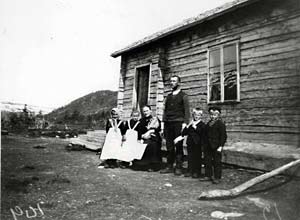The settlers
During the 16th century the first attempts to colonise Vilhelmina were made. Agriculture is in other words a very late occurrence in these areas, at least if you consider how long people have actually lived here.
Ever since the inland ice in this area melted around 10 000 years ago, people survived mainly by hunting wild animals like moose, raindeer, birds and fish. This was the way of life in these parts of the land up until the Middle Ages. Depending on the season and on the access to food, people led a nomadic life and moved between different settlements. The Sami culture developed from these early hunting and fishing cultures that have existed in northern Fennoscandia since the Stone Age. The earliest archaeological traces that indicate that the Sami kept domesticated reindeer and led a nomadic lifestyle herding the raindeer date from the centuries soon after the birth of Christ.
The colonisation of Lapland
During the 15th century, a more extensive reindeer husbandry with large herds of domesticated reindeer developed. At around the same time the government started showing an interest in Lapland. The government had problems raising taxes and controlling the Sami trade. They also knew that the Swedish mountains were filled with ore that could possibly be extracted if there was access to labour in the area. If the government could persuade Swedish farmers to settle in Lapland there was also a future possibility of taxing homesteads. The idea was that farmers and raindeer herders would live side by side. The settlers were promised tax freedom for about 15-30 years. They were also excused from joining the army and had free access to land for housing and farming. The settlers were also free to fish and hunt to a certain extent. In return, the settlers were obligated to build houses and farm the land. After the years of tax freedom had passed, the worth of the settlement was calculated and a proper tax was decided upon.

Grundfors 1903. Foto: Helge Dahlstedt. Källa: Vbm.
In the end, both Swedes and Sami became settlers. The first colonisation attempt in Vilhelmina was made by the Sami Sven Jakobsson in Råsele. The year was 1726. This settlement was abandoned in the 1740’s. Not far from there, Erik Pålsson from Åsele settled down. Since this is the first settlement that was officially tax liberated, it is formally considered the oldest in Vilhelmina. Between the years 1750 and 1890, over a hundred tax liberated settlements in Vilhelmina were assessed and taxed. During this era there was, contrary to the hopes of the government, never any extraction of ore in this area.
Where did the settlers come from?
Many of the settlers came from the parishes alongside the Ångermanland river. Many poor maids and farmhands came from the Anundsjö, Åsele and Själevad parishes. They dreamt of creating their own home in Lapland. There were also settlers from the countys Dalarna, Norrbotten and the coast of Västerbotten. In rare cases, even ex soldiers and more highly educated men and women grasped the opportunity to start a new life in the wilderness of Lapland. Sweden was involved in several wars during the 16th century and that too could have been a reason for people to try their luck in Lapland, since the settlers weren't drafted to war.
Livelyhood
Looking at the decrees issued in the 15th and 16th century, the Swedish government had high hopes that the settlers were going to be able to make a living on their farming. In hindsight it's obvious that it wasn't the agriculture that kept the early colonists alive - it was the live stock, the hunting and the fishing. It was of utmost importance for a settler to live close by good fishing waters and good haylands. The live stock were often fed grass harvested on bogs or along creeks.
Even though the odds for successful agriculture in the inland of northern Sweden were slim, it's remarkable how much land the settlers managed to cultivate. Especially considering the simple tools they had at their disposal. Through persistence and hard work they managed to cultivate little grain fields and potato slopes. Maybe it is not that strange that the pioneering spirit and lives of the settlers often are idealised in both literature and storytelling.